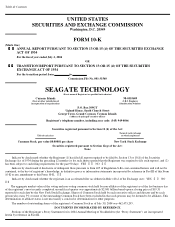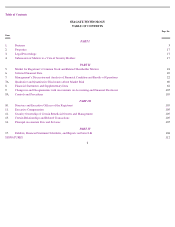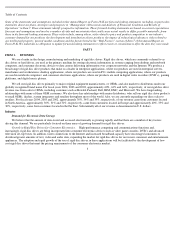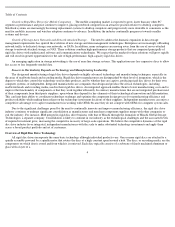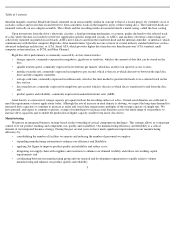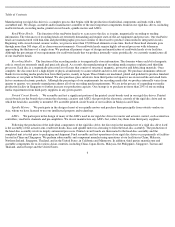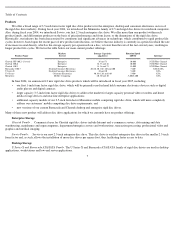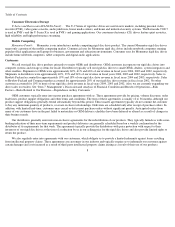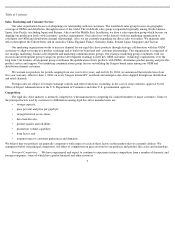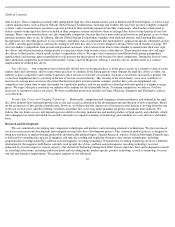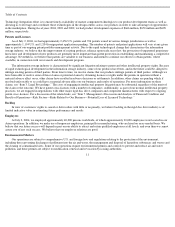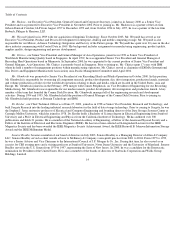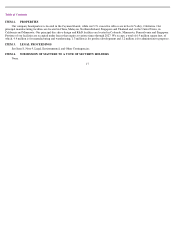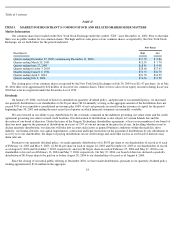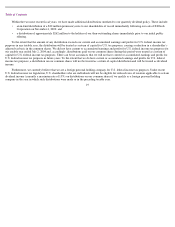Seagate 2003 Annual Report Download - page 12
Download and view the complete annual report
Please find page 12 of the 2003 Seagate annual report below. You can navigate through the pages in the report by either clicking on the pages listed below, or by using the keyword search tool below to find specific information within the annual report.
Table of Contents
Technology Integration effort is to ensure timely availability of mature component technologies to our product development teams as well as
allowing us to leverage and coordinate those technologies in the design centers across our products in order to take advantage of opportunities
in the marketplace. During fiscal years 2004, 2003 and 2002, we had product development expenses of $666 million, $670 million and $698
million, respectively.
Patents and Licenses
As of July 2, 2004, we had approximately 2,456 U.S. patents and 726 patents issued in various foreign jurisdictions as well as
approximately 1,194 U.S. and 1,204 foreign patent applications pending. The number of patents and patent applications will vary at any given
time as part of our ongoing patent portfolio management activity. Due to the rapid technological change that characterizes the information
storage industry, we believe that the improvement of existing products, reliance upon trade secret law, the protection of unpatented proprietary
know-
how and development of new products are generally more important than patent protection in establishing and maintaining a competitive
advantage. Nevertheless, we believe that patents are valuable to our business and intend to continue our efforts to obtain patents, where
available, in connection with our research and development program.
The information storage industry is characterized by significant litigation relating to patent and other intellectual property rights. Because
of rapid technological development in the information storage industry, some of our products have been, and in the future could be, alleged to
infringe existing patents of third parties. From time to time, we receive claims that our products infringe patents of third parties. Although we
have been able to resolve some of those claims or potential claims by obtaining licenses or rights under the patents in question without a
material adverse affect on us, other claims have resulted in adverse decisions or settlements. In addition, other claims are pending which if
resolved unfavorably to us could have a material adverse effect on our business and results of operations. For more information on these
claims, see “Item 3. Legal Proceedings.” The costs of engaging in intellectual property litigation may be substantial regardless of the merit of
the claim or the outcome. We have patent cross-licenses with a number of companies. Additionally, as part of our normal intellectual property
practices, we are engaged in negotiations with other major rigid disc drive companies and component manufacturers with respect to ongoing
patent cross-licenses. For a discussion of the related risks, see “Item 7. Management’s Discussion and Analysis of Financial Condition and
Results of Operations—Risk Factors—Risks Related to Our Business—Potential Loss of Licensed Technology.”
Backlog
In view of customers’ rights to cancel or defer orders with little or no penalty, we believe backlog in the rigid disc drive industry is of
limited indicative value in estimating future performance and results.
Employees
At July 2, 2004, we employed approximately 40,000 persons worldwide, of which approximately 30,000 employees were located in our
Asian operations. In addition, we make use of temporary employees, principally in manufacturing, who are hired on an as-needed basis. We
believe that our future success will depend in part on our ability to attract and retain qualified employees at all levels, and even then we cannot
assure you of any such success. We believe that our employee relations are good.
Environmental Matters
Our operations are subject to comprehensive U.S. and foreign laws and regulations relating to the protection of the environment,
including those governing discharges of pollutants into the air and water, the management and disposal of hazardous substances and wastes and
the cleanup of contaminated sites. Some of our operations require environmental permits and controls to prevent and reduce air and water
pollution, and these permits are subject to modification, renewal and revocation by issuing authorities.
11


